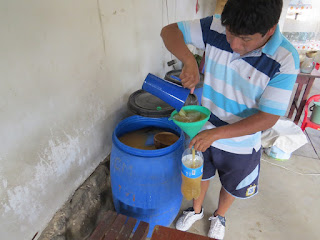September
24, 2015
Today we
returned to Cerro Tunari, this time heading directly to the higher slopes to
beat the frequent mid-day fog or thunderstorms (often with snow) and to take
advantage of heightened bird song activity. Here’s the view looking down onto
the city of Cochabamba from the near the point where we started birding.
We first
targeted canasteros today, and we scored big, with five species. There aren’t
many places where you can see five of these often skulking furnariids in a
single morning. They are members of a radiation of largely southern temperate
ovenbirds including thornbirds and tit-spinetails that make complex nests of
sticks; this genus’ name comes from the Spanish word canasta, which means basket. Canastero
means basket maker, referring to their nests.
The common
and not-so-shy Creamy-breasted Canastero was found easily from the bus as we
drove up, and we had seen them well two days ago. Then in the uppermost scrubby
Polylepis groves we coaxed out a
Maquis Canastero, with its especially long tail almost more like the related
tit-spinetails. In this same habitat we spotted this Red-crested Cotinga
displaying at another, unseen bird. I’ve seen the crest raised like this only a
few times; usually one asks why it would be called “red-crested” when no such
crest is visible.
Higher up in
the lower bunch grass we located a Puna Canastero that came in quite close.
Just a bit higher up we found Scribble-tailed Canastero, which I’ve had here
only a couple times, and which we dipped on two days ago. It seems that early
morning is important to catch them singing. I got one photo that barely shows
its namesake.
Our final
species was Cordilleran Canastero, found in the highest elevations, free of
shrubs and bunchgrass, where it scurries amongst boulders instead.
We didn’t
see many other species at this elevation, the highest point we reached being
14,860 feet (4530 meters) above sea level. But the scenery was fabulous.
And the
plants fascinating. An Anemone sp.
A cushion cactus
probably pollinated by Andean Hillstar.
A Viola sp.
This isn’t
the best season for butterflies, but we saw a few sulphurs (probably Colias species), and my eyes caught the
movement of this rarely seen Itylos
titicaca, Titicaca Blue.
And of
course there are some birds here, some specialists in this habitat. This is the
widespread Ash-breasted Sierra-Finch.
This Slender-billed
Miner responded to my recorded song by doing an extended display flight like a
lark above us.
We found just
these two White-fronted Ground-Tyrants on a flat resembling a putting green.
White-winged
Diuca-Finches are found only in this high tundra-like habitat as well.
Back in town
in the late afternoon we made a stop at a house that was flying a small white
flag at the end of a long stick overhanging the side of the road. This
indicated they were selling Chicha Cochabambina, a corn beer made with corn
meal, water, sugar, and environmental yeast. It’s slightly sour, and it tastes
like cross between beer and champagne. If you bring in an empty liter water
bottle, they’ll fill it for about $1 US.
This sign
indicates what is for sale in this tiny neighborhood store – bread, milk, white
cheese, coca leaves, and beer (the brand Paceña, from La Paz). I had bought a
small bag of coca leaves elsewhere on the tour for our participants to try –
but only two or three dared try this harmless herb. Cocaine is made from it but
is present only in minute quantities and must be refined with huge amounts of
leaves and chemicals. Putting 20 leaves in your mouth and adding some legia to release the alkaloids does
produce a numbing sensation in the tongue and gums, and using more is said to
suppress appetite, fatigue, and altitude sickness, but I’ve never noticed
anything other than the numbness. One certainly does not get any sort of “buzz”
from it, any more than one would get high from someone smoking a marijuana
joint at the far end of a football field.
Tomorrow is
our last day here, but with a late evening flight, we actually have virtually
all day. We did really well at Cerro Tunari, and we still have a chance to see
some new things in the wetlands around the city, so we’ll be taking it easy
after what has been a tiring but fun itinerary.























No comments:
Post a Comment